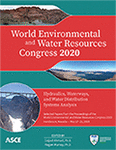World Environmental and Water Resources Congress 2020
Where Are the Loops?
Publication: World Environmental and Water Resources Congress 2020: Hydraulics, Waterways, and Water Distribution Systems Analysis
ABSTRACT
Loops in water distribution networks (WDN) provide redundancy. There are surrogate measures of redundancy, quantifying the percentage of actual loops to maximum potential loops for a given network. However, it has been noted in the literature for over three decades that not all loops are equal or contribute to redundancy in the same way. There is a gap in differentiating between WDN layouts with the same percentage of loops, bypassing key network properties. This study applies a method previously used for biological network analysis, to capture more detail on WDN loops. Specifically, this method decomposes the original graph of the WDN to a tree graph, a network model representing loop connectivity. Analyzing such a network model is promising for enhancing the quantification of WDN redundancy and robustness. Measures of loop connectivity are then compared with hydraulic simulation data for benchmark WDN(s).
Get full access to this article
View all available purchase options and get full access to this chapter.
ACKNOWLEDGEMENTS
This material is based upon work supported by the National Science Foundation under Grant Number 1638301. Any opinions, findings, and conclusions or recommendations expressed in this material are those of the authors and do not necessarily reflect the views of the National Science Foundation.
REFERENCES
Diao, K, Sweetapple, C, Farmani, R, Fu, G, Ward, S, Butler, D. Global resilience analysis of water distribution systems. Water research 2016;106: 383-93.
Dziedzic, R, Karney, BW. Performance index for water distribution networks under multiple loading conditions. Journal of Water Resources Planning and Management 2015;142(1): 04015040.
D.G. Eliades, M. Kyriakou, S. Vrachimis and M.M. Polycarpou, "EPANET-MATLAB Toolkit: An Open-Source Software for Interfacing EPANET with MATLAB", in Proc. 14th International Conference on Computing and Control for the Water Industry (CCWI), The Netherlands, Nov 2016, p.8.
Farmani, R, Walters, GA, Savic, DA. Trade-off between total cost and reliability for anytown water distribution network. Journal of Water Resources Planning and Management 2005;131:(3)161-71.
Farmani, R, Butler, D. Implications of urban form on water distribution systems performance. Water resources management 2014;28(1):83-97.
Gheisi, A, Forsyth, M, Naser, G. Water distribution systems reliability: A review of research literature. Journal of Water Resources Planning and Management 2016;142(11):04016047.
Giustolisi, O, Simone, A, Ridol, L. Network structure classi_cation and features of water distribution systems. Water Resources Research 2017;53:(4)3407-23.
Goulter, I. Current and future use of systems analysis in water distribution network design. Civil Engineering Systems 1987;4:(4)175-84.
Hernandez, E., Hoagland, S., & Ormsbee, L. (2016). Water distribution database for research applications. In World Environmental and Water Resources Congress (pp. 465-474).
Katifori, E, Magnasco, MO. Quantifying loopy network architectures. PloS one 2012;7(6):e37994.
Klise, KA, Bynum, M, Moriarty, D, Murray, R. A software framework for assessing the resilience of drinking water systems to disasters with an example earthquake case study. Environmental modelling & software 2017;95:420-31.
Liu, H, Walski, T, Fu, G, Zhang, C. Failure impact analysis of isolation valves in a water distribution network. Journal of Water Resources Planning and Management 2017;143(7):04017019.
Meng, F, Fu, G, Farmani, R, Sweetapple, C, Butler, D. Topological attributes of network resilience: A study in water distribution systems. Water research 2018;143: 376-86.
Ronellenfitsch, H, Lasser, J, Daly, DC, Katifori, E. Topological phenotypes constitute a new dimension in the phenotypic space of leaf venation networks. PLoS computational biology 2015;11(12):e1004680.
Singh, V, Fiorentino, M. A historical perspective of entropy applications in water resources. In: Entropy and energy dissipation in water resources. Springer; 1992. p. 21-61.
Tanyimboh, T, Templeman, A. Optimum design of flexible water distribution networks. Civil Engineering Systems 1993;10:(3)243-58.
Todini, E. Looped water distribution networks design using a resilience index based heuristic approach. Urban water 2000;2(2): 115-22.
Walski, TM. Water distribution valve topology for reliability analysis. Reliability engineering & system safety 1993;42(1): 21-7.
Walski, TM. Valves and water distribution system reliability. In: AWWA National Convention, New York, NY. 1994.
Xu, C, Goulter, IC. Reliability-based optimal design of water distribu tion networks. Journal of Water Resources Planning and Management 1999;125:(6)352-62.
Yazdani, A, Jeffrey, P. Complex network analysis of water distribution systems. Chaos: An Interdisciplinary Journal of Nonlinear Science 2011;21(1):016111.
Information & Authors
Information
Published In
World Environmental and Water Resources Congress 2020: Hydraulics, Waterways, and Water Distribution Systems Analysis
Pages: 421 - 428
Editors: Sajjad Ahmad, Ph.D., and Regan Murray, Ph.D.
ISBN (Online): 978-0-7844-8297-1
Copyright
© 2020 American Society of Civil Engineers.
History
Published online: May 14, 2020
Published in print: May 14, 2020
Authors
Metrics & Citations
Metrics
Citations
Download citation
If you have the appropriate software installed, you can download article citation data to the citation manager of your choice. Simply select your manager software from the list below and click Download.
